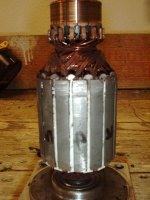dogman said:
Never thought about balancing much, but have often pondered why a really expensive tire can be so out of round right out of the box. When a good tire suddenly gets out of round, it's because the cord inside is breaking down. Usually from potholes and curb hopping.
I have a narrower Kenda similar to the Kross (flat center, knobby edge) I just got from someone when helping them fix their bikes; it actually has one side's bead slightly larger diameter than the other, and it will not seat on most of the rims I have (or the cheapie one it started out on. It pops out in one spot or another once inflated. It appears to have simply been made wrong, as it was always this way for them since they got the bike. It was bulging so bad that they had taken off one of the rim brake pads so it would stop rubbing the tire.
I have a narrower rim with slightly taller walls that it might stay on, but basically it's just defective. It's still so new that it still has all the little molding flashing on it in the center of the flat tread area and no wear marks at all.
As for balancing wheels, there are a lot of things you could use to create balance. Have you ever seen those little janglies on kids' bikes; little plastic clip-ons that slide up and down the spokes and make noise as they ride slowly around? You could use those with some glue in the center to keep them from sliding, and put them on the spokes as needed to balance.
The actual act of balance-testing I'm not sure about, but I can imagine a device to do it, that would hold the tire horizontally, like a cieling fan. It would use an axle holder only on the top end of the axle that has a freely-movable ball joint on it, to allow the wheel to swing sideways as centrifugal forces pull it away from the center in areas where it is unbalanced. A pointed object (nail, etc) would be secured to the other end of the axle, pointing down, and centered above a point marking on something (a table, etc) below the balancer.
If it's a motorized wheel, it's easier to check, by just running the motor at various speeds to see how much wobble one gets out of it. Add or move weights around until it no longer wobbles and the pointer stays centered over the dot. Determining where to put the weights is harder, and would require either careful observation at slower speeds, or a high-speed camera to see what part of the rim is in the direction of the wobble. I'm sure there's a delay in that, so the weight probably has to go just forward of where the max wobble shows up, but I don't know how to calculate that.



